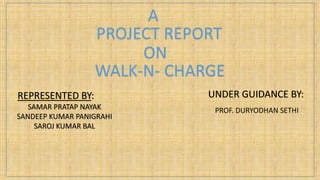
Walk n charge
- 1. A PROJECT REPORT ON WALK-N- CHARGE REPRESENTED BY: SAMAR PRATAP NAYAK SANDEEP KUMAR PANIGRAHI SAROJ KUMAR BAL UNDER GUIDANCE BY: PROF. DURYODHAN SETHI
- 2. ABSTRACT: This project is designed to ensure that our cell phones never run out of juice by letting us charge it while we are on our daily walk and getting some exercise and thereby getting two jobs done at the same time . The basic idea is about converting a part of the bio-mechanical energy spent in our day-to-day lives(while walking) into a usable form and storing it to charge low-power battery operated device.
- 3. CONTENT: 1. INTODUCTION 2. HOW DOES IT WORKS 3. OPERATION 4. PERFORMANCE OF THE CHARGER 5. ADVANTAGES 6. CONCLUSION
- 4. Walk-n-charge is one of the technologies used to charge the low-power operated devices like mobile phone batteries, MP3 player batteries, etc while you walk. Two technologies have been tested so far to convert energy used in walking into electrical power. INTRODUCTION: 1. Uses of piezoelectric material. 2. Placing small electro-mechanical devices, such as a dynamo. Use of piezoelectric material • This gets compressed while you walk and generates a substantial voltage, which when combined with appropriate electronics, can be used to charge a mobile phone battery. • The piezoelectric device generates about 150 milliwatts of power as of now, which is not sufficient to run a cell phone, but would be enough to charge the battery slowly. By placing small electro-mechanical device • It involves placing small electro-mechanical devices, such as a dynamo, in the heel of the shoe. The dynamo spins every time your heel strikes the ground, thereby generating a small amount of current. • The dynamo technology has the potential of generating much more power than piezoelectric material.
- 5. OPERATION: The mechanism involves three basic stages: Conversion of mechanical to electrical energy Storing the electrical energy Using this energy to charge mobile phone MECHANICAL TO ELECTRICAL ENERGY STORING THE ELECTRICAL ENERGY USING THIS ENERGY TO CHARGE YOUR DEVICE
- 6. HOW DOES IT WORKS ? Work n Charge is worn below the knee cap on one leg and a light string is attached to the other leg. The strides taken help in pulling and retracting the string, which is further attached to a dynamo that generates about 3.5 Watts; enough to charge low-powered devices like mobiles, MP3 players, GPS devices, etc Walk-N-Charge is about converting a part of the bio-mechanical energy spent in our day-to-day lives (while walking) into a usable form and storing it to charge low-power battery-operated devices. Walking involves a change in relative displacement of around 35 cm between legs. This repeated linear motion could be converted to rotary motion with the help of a pulley and string. Thus, the bio-mechanical work is converted into mechanical form and eventually stored as chemical energy in batteries to store electric energy. The device is clamped on one leg using a Velcro strap and a hole lets out a Nylon string that is attached to the other leg that helps in the conversion of the displacement into rotary motion.
- 7. Even a slight displacement pulls the string out, thereby rotating the pulley, which turns the central shaft. The shaft is common to the gearbox, the dynamo and the recoil mechanism. So, when the displacement reduces, there is a slack in the string, which is removed by the tension produced by the recoil system. Since the electricity produced is bi-directional and contains spikes, an electronic circuit encompassing a rectifier and a filter converts it into a unidirectional, spike-free wave and stores the energy produced in rechargeable batteries. This stored energy is used as an input supply to mobiles with the help of different adapters.
- 8. PERFORMANCE OF THE CHARGER: Each Walk-N-Charge is capable of generating minimum 3.5 Watts of power at normal walking speed (4 km/h). An intermittent walk of 20 minutes is sufficient to charge a mobile with around 1 hour talk time, which can be considered as an average person’s phone usage for a day. For a person with an average walking of half an hour per day, this device can generate 2 W/h of energy.
- 9. ADVANTAGES AND FUTURE PROSPECTIVES: Increasing the effectiveness of mobiles in rural india by providing a portable means of charging of mobiles,torches,radios. Helping military personnel charge their GPS devices and other low-power electronic gadgets while on the move. Providing an alternate means to wall-based charging for MP3 players, mobiles, etc in cities, thereby, helping today’s fast generation to move faster without mobile battery problems. India has signed the Kyoto Protocol – an acknowledgement that we share the concern of global warming, which also expresses our commitment to slow down climate change. Walk-N-Charge would just add to the efforts put in by India in various innovative ways. Charging your cell phone might soon be as simple as taking a walk around the block.
- 10. CONCLUSION: Hence, walk-n-charge is the best idea for battery charging. Even if 0.1% of the Indian population uses this device, it can generate 1500 kW/h of energy and can help reduce carbon emission by 2.25 tonnes per day. Thus, Walk-N-Charge promises you a source of energy that is not only clean, portable and inexpensive, but also charges your mobile while you get charged up!
- 11. REFERENCE: 1. Rocha. J.G, Gonçalves L. M, Rocha .P. F, Silva. M. P., And Lanceros-Méndez. S. (2010) “Energy Harvesting From Piezoelectric Materials Fully Integrated In Footwear‟- IEEE Transactions On Industrial Electronics, Vol. 57, No. 3, March 2010 2. Faruk Yildiz Sam “Energy Harvesting From Passive Human Power “Houston State University International Journal Of Innovative Research In Science, Engineering And Technology Vol. 2, Issue 7, July 2013 3. www.google.com